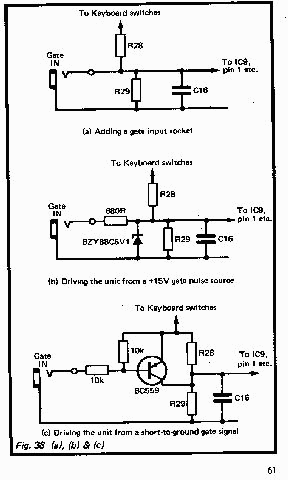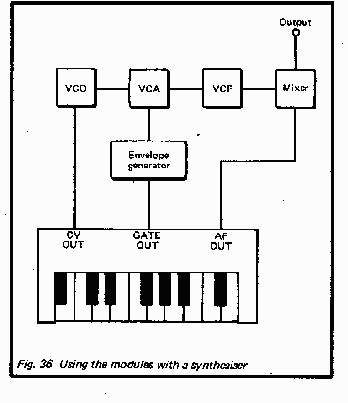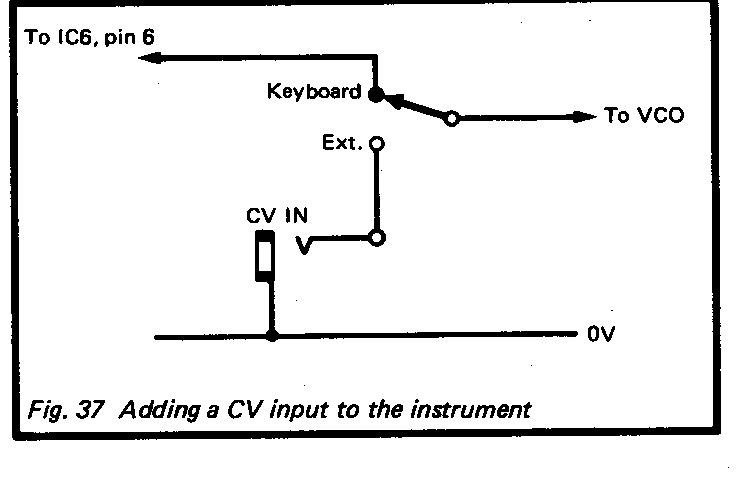Chapter 2
THE MODULES
Construction
Printed circuit designs for the main modules are provided in Figures 24 to 35, and these should considerably ease the task of building what is not a particularly simple piece of equipment when taken as a whole.
The minor circuits, if required, can easily be built on stripboard if you do not wish to design your own printed circuit boards for them. Construction should be generally straightforward from the electrical point of view.
Bear in mind that the CA314OE, CA3240E ' and 4OU1BE devices utilized in some of the modules are MOS input types, and that they consequently require the standard antistatic handling precautions. Use integrated circuit holders for these devices, and do not plug them into circuit until the unit has been completed in all other respects. Until then, leave them in the antistatic packaging (usually this is a plastic tube or conductive foam). When fitting the devices handle them no more than is really necessary, and avoid any obvious sources of strong static charges (nylon carpets, etc.).
Mechanically the standard synthesiser arrangement is to have the keyboard and the electronics in one unit, with the control panel just to the rear of the keyboard, and either vertical or at an angle of about 30 to 45 degrees. For a home constructed instrument I prefer a slightly' different arrangement, with a large ready-made case to house the main electronics and the keyboard constructed as a separate unit.
An attractive case for the keyboard can easily be made using chipboard and a plastic veneer of some kind, but the exact dimensions and form of the case must be varied to suit the particular type concerned. Note that many keyboards are little more than the keys and a frame on which they are mounted, and the switch contacts must be added by the constructor using parts available separately. You should therefore make quite sure you know what you are buying, and what extras are needed, before ordering the keyboard.
The keyboard circuit should be fitted in the same housing as the keyboard, and not with the main electronics. This avoids having a cable with a large number of ways connecting the keyboard to the main unit. In fact just four connections are required (+12V,-12V, 0V, and output). Ideally the coupling should be made via a length of coiled cable, a system used successfully with many business computers, although as yet little used in the field of electronic music.
Note that the keyboard printed circuit does not accommodate the resistor chain, apart from the tuning preset that is. Obviously the number of resistors required will vary depending on which particular keyboard you use, which would make it awkward to design a printed circuit board to suit any keyboard. Anyway, where possible it is far better to mount the components in the resistor chain actually on the keyboard switches, as a lot of hard wiring will otherwise be required.
When dealing with the mains power supply the normal safety precautions should be observed. The case must be a type which has a screw fitting lid or cover so that easy access to the dangerous mains wiring is not possible. Ideally any exposed mains wiring should be insulated. Any exposed metalwork should be earthed to the mains earth lead, as should the 0 volt supply rail. The most practical approach is probably to use a case of all metal construction, and to earth this to the mains earth lead. Anything metal such as a transformer which is mounted on the case will then be earthed, as will any fixing bolts. Some synthesisers are constructed in such a way that leads can be used to patch the modules together in the desired way, but this is probably only worthwhile in the case of a large instrument which has many modules and a large range-of possible methods Of interconnection. With more simple instruments a few switches can usually take care of all the likely possibilities. Also, if you use the mixer circuits described earlier the appropriate controls can be set back to zero to cut out a feature that is not required (to cut out the noise generator for example, or to prevent any keyboard voltage from being fed to the control input of the VCF).
Adjustments
The modules have been designed so that as far as possible no adjustments are required before they are ready for use. In a few cases this is not possible, and there is one preset resistor in the keyboard circuit. However, adjustment of this was covered previously and this ground will not be covered again here. The only other presets are the two in each logarithmic to analogue converter circuit. When adjusting a converter that is d riving a VCO, RV2 is adjusted to give the correct note with the lowest note of the keyboard being operated. Obviously pitch pipes or another (in-tune) instrument is required as a tuning reference when doing this. RV2 gives a wide adjustment range, and the base note can be set at anything from about one octave above middle “C” to two octaves below middle “C”. You may prefer to have this as a front panel control rather than a preset type. This has two advantages, one of which is that it makes it easier to retune the instrument should the tuning drift slightly, and all analogue synthesisers seem to be prone to slight tuning drift. It also enables the tuning to be easily shifted if you wish to (say) offset one VCO from another by a fifth, or to move the compass of the instrument down an octave. RV1 is adjusted to give the correct pitch with a note near the upper end of the keyboard operated. It is advisable to adjust RV2 and RVI in turn a few times to make quite sure that the instrument is tracking properly over the full range of the keyboard. If the converter is used to drive a VCF, the way in which it is set up will to some extent depend on the exact way in which the VCF is being utilized, and in general things will be less critical than when driving a VCO. The basic effect of the two controls is the same as when driving a VCO, with RV2 setting the base frequency and RV1 setting the sensitivity. When driving the circuit from the mixer circuit of Figure.19 the settings of RVI will not be at all critical, and simply setting it at about half value should suffice. RV2 can be given any setting which enables the three mixer controls to be set up so that the filter tracks the keyboard correctly. This is done by setting the frequency control to give the correct frequency with the lowest note played, and adjusting the “keyboard” control to give the correct cutoff frequency with a high note played. The-envelope control should be set at minimum. Adjustment of the “frequency” and “keyboard” controls should be repeated a few times in order to ensure accurate tracking on occasions when accurate tracking is essential.
Using The Modules
Although primarily intended to be utilized as a full synthesiser in their own right, there are other ways of using the modules. For example, an arrangement such as that shown in Figure 36 can be adopted in order to add to the facilities of an existing analogue synthesiser (which must have a I volt per octave CV characteristic and a +5 volt gate output signal).
The idea here is to effectively give the synthesise an extra VCO, and this can provide a very worthwhile improvement in performance with a simple single oscillator instrument, but is also a useful expansion with 'more complex instruments.
The control voltage for the VCO is provided by the CV output of the synthesiser. If you require the ability to switch between the home constructed synthesiser's own keyboard and an external CV source, all that is required is a simple switching circuit of the type shown in Figure 37. It would in fact be possible to use switch contacts on the CV input socket to automatically provide the switch-over, but in practice it will probably be more convenient to have a separate switch.
The gate output of the synthesiser is used to drive the envelope generator in the manner shown in Figure 38a. This seems to work perfectly well provided the gate output signal is at standard 5 volt logic levels (which is, unfortunately, not the case with all instruments). With a type which has a + 15 volt gate output signal the zener clipping circuit of  Figure 38b would have to be added to protect the input circuitry of the envelope generator. With the type that provides a “short-to-ground” gate signal the arrangement of Figure 38c should give the desired result, although I have not had the opportunity to fully test this circuit and it is only put forward as a recommended line of experiment for those with the appropriate type of synthesiser.
Figure 38b would have to be added to protect the input circuitry of the envelope generator. With the type that provides a “short-to-ground” gate signal the arrangement of Figure 38c should give the desired result, although I have not had the opportunity to fully test this circuit and it is only put forward as a recommended line of experiment for those with the appropriate type of synthesiser.
A mixer is used to combine the signals from the two instruments into a single output. With a simple arrangement of the type outlined here it is possible to generate some interesting sounds. The main point to bear in mind, and to exploit to the full is that the two instruments have separate envelope shapers, and the signal from one synthesiser can have a totally different envelope shape to the other. This enables some interesting results to be obtained, with the system effectively providing envelope shapes that are not available with a single ADSR envelope shaper. The two synthesisers have separate filters as well, which can also be used to give some excellent effects. Bear in mind that the two instruments do not need to be tuned to the same octave, or even the same note. In Figure 36 the home constructed synthesiser is shown as a very basic type, but by adding extra modules, such as a separate envelope generator for the VCF it is possible to further expand the range of available sounds.
A very useful application for a home constructed synthesiser in conjunction with a ready-made type (or another home built instrument for that matter) is as a simple percussion synthesiser. In this role the gate signal is provided by an external source, which would normally be in the form of some kind sequencer. It could be provided by the main synthesiser, but this would result in the percussion sound being generated each time a note was played, which is not normally what is required. Sequencers are covered in the next chapter, and this subject will not be pursued further here.
Many percussion sounds are noise based, and are therefore only available if the instrument is equipped with a noise generator. However, by using an envelope shape which has a fast attack and slow decay, a fairly low VCO frequency, and the VCF set to give only a low harmonic content on the output signal, some quite good drum sounds can be obtained. By sweeping the VCO with the output of the envelope generator some good falling pitch and “disco” drum sounds can be produced.
Of course, many synthesisers these days do not have the CV/ gate type of interface, but instead have a MIDI (musical instruments digital interface) type. This is a fully digital type of interface which is completely incompatible with CV/gate interfaces. However, analogue instruments can be driven successfully from MIDI equipment with the aid of a suitable converter. MIDI goes well beyond the scope of this book, but details of some MIDI equipment (including a MIDI to CV/gate converter circuit) can be found in Book No. BPI82 “MIDI Projects”, from the same publisher and author as this publication.

